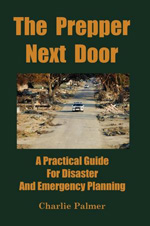One topic I didn’t go into detail about in The Prepper Next Door was cooking. What are your options for cooking during a disaster?
One option is the good old charcoal grill or bar-be-cue. Used outside, all you’d need is the BBQ itself, charcoal, and lighter fluid. You can purchase charcoal BBQ grills or if you’re handy with metal, you can build your own.
To build your own, find a metal barrel in good condition and cut it in half, lengthwise. Use angle iron to weld together some legs and a frame. Use angle iron to cover the nasty sharp edge around the cut and to strengthen the barrel. The grill will close angle iron to angle iron. Add a handle on one side to the top half and add hinges on the other. Inside, you’ll want to build a removable box for taking out the ashes. Use a heavier metal.
Add a removable grill over the top of the bottom barrel (set down slightly, so the top and bottom close together) and a tiny chimney at the top. You can drill some holes through the top, so a spit steel can run through and allow you to cook turkeys. Build a holder for a rotisserie motor. Add some wheels on the legs.
When I was a kid, my dad built many of these. I couldn’t find any online designs as nice as his, but here are some other designs:
Barrel Barbecue (metals.about.com)
Another option is a camping stove. I had one of the Coleman Liquid Gas stoves, but gave it away years ago. It’s a good way to cook. (Giving it away is one of my prepper hall of shame decisions). Here’s a discussion about them on campingblogger.net.
If you bug out, a grill with folding legs are great. These come in larger sizes that are nice too. Wood would be your fuel.
To learn about cooking outdoors, we can turn to campers and woodsmen. In one of those Blast From The Past moments, I dug out a book I had: Backcountry Cooking by J. Wayne Fears. It was published in 1980 and isn’t published today. But, I bet you can find a similar book.
Many outdoor cooks love Dutch ovens. To select a true Dutch Oven, you’ll want one with a flat lid with a rim. Turning the lid over gives you a skillet. Because it sets under coals, it should have legs. The rim allows you to put coals on top of the Dutch oven. Dutch ovens are heavy cast iron, so they spread the heat uniformly to cook.
Here’s a nice discussion of selecting a Dutch oven. The site dutchovendude.com has some good-looking recipes too.
Outdoor cooks like reflector ovens. They use the heat from a fire to bake. Here’s an Boys Life article about reflector ovens.
Here’s a Youtube video of a guy making Bannock bread with a reflector oven:
For cooking in cold climates, the same sheet metal stoves mentioned in the book for heat are one option. They’re called Sheepherder’s stoves.
One useful thing the really-old-timers didn’t have was aluminum foil. Wrap what you want to cook in the foil and place the foil on top of your grill with the folding legs. Or you can toss it in your fire if you’re feeling Grizzly Adamish.
If you’re making steaks on your barrel barbecue, clean some baking potatoes and wrap them in aluminum foil. Put them on the grill around the edges.
Here are some other youtube cooks using aluminum foil:
“Hobo” meal:
Cooking A Fish In Foil:
Tilapia in Tin Foil on the Grill:
Although it would run out in a long-term disaster, having a roll or two of aluminum foil is a great plan for intermediate-term disaster cooking.
As long as we’re talking about woodsman cooking, we might as well talk about some of the old standby survival foods used by Native Americans and settlers in North America. Everyone is familiar with venison jerky.
As we go over in the book, man can’t subsist on lean protein alone. If that’s all you have, you get sick and die. The American Indians developed a way to carry and store animal fat. It’s called Pemmican.
To get vitamins and make it somewhat palatable, berries, nuts, and jerky are added to it. Nobody really much likes it anyway. Pure animal fat and lard isn’t all that tasty. (My favorite source of fat in the modern world is deep-dish pepperoni pizza.)
“Modern Pemmican” did away with the animal fat and used peanut butter. Here’s a good video about making Peanut butter Pemmican
Here’s one more article about pemmican.
Some modern campers just carry their nuts, berries, and jerky separately and add a jug of crunchy peanut butter as another staple.
While pemmican stored fat as a portable food source, another important cooking ingredient is yeast. It’s useful for baking bread. Old time prospectors in Alaska used Sourdough as a yeast source.
Here’s a nice discussion (sourdoughhome.com) of starting a starter dough.
Here are two good videos about Sourdough:
Making Sourdough Starter:
Dan’s SourDough Bread:
There are many options for getting your daily coffee fix today.
Many people think coffeemakers have complex pumps and other gizmos to brew coffee. They’re actually quite simple, but clever. This video I found on youtube explains how a coffee maker works. As you see, heat is the only requirement:
Charlie P. —author, The Prepper Next Door: A Practical Guide For Disaster And Emergency Planning
***
Win a free copy of The Prepper Next Door on The Total Survivalist Libertarian Rantfest (which is a great blog for preppers)
